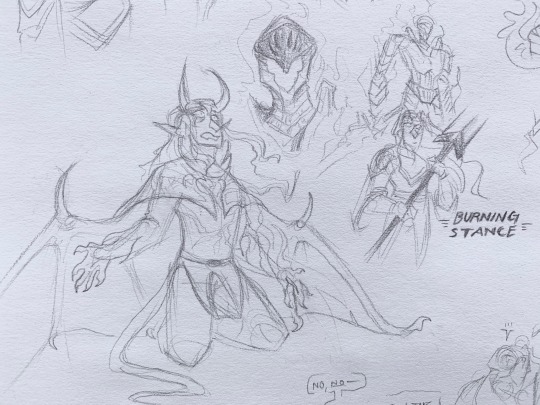#nahal TI
Text





I'M MAKING IT HAPPEN
another femslash february dump, this time hanamusa, Kari/Mira, Xanthe/Hilda/Nahal, Rouge and Topaz, and chelldos!
#hanamusa#team rocket jessie#delia ketchum#space faerie#negg faerie#mirakari#xanahil#xanthe TI#hilda TI#nahal TI#pokemon#thrilling intent#neopets#rouge the bat#topaz sonic#roupaz#sonic#chell portal#glados#chelldos#portal#diana's rad art#femslash february
242 notes
·
View notes
Text

--prompt from @flashfictionfridayofficial
Inbal sauntered out of the house, before heading towards the sidewalk and found herself swaying in the overcast evening. even with her heavy leather jacket wrapping her torso, she still felt a biting chill enter there before sliding down her legs and into her boots. Indifference is a tolerable shield, but rage simmered under her skin.
No "promise you'll write" from this mysterious girl; she just vanished and was considered "dead" for many years. Digging into the papers of her memory, she never imagined her parents nor her brothers venturing to the graveyard to see Nata--though she re-shuffled that deck as she remembered--nobody would tell her about death or what could happen afterwards. Instead, she focused on her dolls and trying to get her spelling correct for school.
But who did ima cherish the most, out of all of us? She thought, sifting through hills and finding a cove of evergreens to shield herself in. It should be equal, or at least she would take note of things that weren't in the family business. But she did care about me, a lot...
And then her mother arrived, looking through the trees to find any light. She wrapped herself around her coat, though her hands peaked out and let themselves become vulnerable through the night. Her rings shone through the stray streetlamps, though they maintained a cool, blue edge.
"Why did you run out of the house?" she chastised her daughter, her voice making the whole atmosphere tremble. Inbal turned her head ninety degrees; however, she didn't let the rest of her body follow in pursuit.
"You didn't tell me I had a sister," she replied. "I thought she was dead!"
Shira held her breath, before slowly exhaling. "It was for her safety, Inbal. I didn't know better and the people who tried to hurt us demanded a body from me."
Inbal twisted her lips. They traveled here for her brother, to make sure their next deal was tied up in a bow. But something else etched on her chest, emerging from the cold parts of her body and into the evening air.
"And my aunt, Nahal?" She muttered, the otherwise sharp tone in her voice diluting into a fragile whisper. "Have you kept in touch with her?"
Despite the fermenting darkness building up, Shira came over and placed her hand on Inbal's shoulder. The daughter trembled as she pondered over the last time she saw her aunt--the days tumbled into weeks and months and then years. Not even a foggy image appeared in her mind, which made her shiver even more.
"I don't know what happened to her," Shira replied. "There was an earthquake here and I just never heard from her again."
#flash fiction#my writing#writers on tumblr#iodine#mystery#speculative fiction#family#family issues#third person#grief#revelation#crime novel#wip
8 notes
·
View notes
Text
Relatives of those kidnapped by Hamas ask Madrid for help: "It's not Israel's problem, it's everyone's problem"


Mayan Segal-Koren, whose mom and different family have been kidnapped throughout a Hamas assault in Israel, throughout a press convention in Madrid, Oct. 26.Claudio AlvarezA bunch of family of Israelis kidnapped by Hamas on October 7 requested in Madrid this Thursday that the Spanish society, the appearing authorities of Pedro Sánchez and the worldwide neighborhood assist them to free their family members. "This isn't an Israel downside, this can be a downside for the entire world, Hamas have to be stopped right this moment," shouted Nama Weinberg, whose cousin was kidnapped and killed at a information convention held at a kibbutz (agricultural cooperative) of her uncles. . Headquarters of the Jewish Neighborhood of Madrid. The occasion, attended by 5 family of the kidnapped and who've additionally visited different cities to induce the federal government to prepare their launch, came about with out assurances from the Islamic militia, which the US and the European Union take into account a terrorist group. Extra info: 50 hostages killed in Israeli bombing."The felony abduction of such a lot of civilians is unprecedented on the planet, a real case of warfare crime, with all its worldwide, ethical, authorized and diplomatic implications," stated Mayan Segal-Koren. The mom and different family have been kidnapped from a kibbutz. This Thursday, the Israeli military detained a minimum of 224 folks; 1,400 killed in Hamas assaultextra info"What we hear from survivors is like tales of the Holocaust, dad and mom killed in entrance of youngsters, and youngsters who have been kidnapped and are actually alone in Gaza," stated Merav Mor Raviv, who has an uncle, a cousin. And his son is imprisoned. "My cousin was later discovered along with his arms tied and his physique riddled with bullet holes," lamented the girl, who additionally recalled that her uncle had all the time been a "peace activist". "We're a household that loves peace, my uncle helped kids transfer from Gaza to Israel for higher well being care," she stated. However in his kibbutz, the place his uncles had been dwelling "for greater than 60 years," they kidnapped "about 80 folks from 9 months to 85 years previous." "They got here in, killed folks, burned their homes, there have been dad and mom and three kids inside," he denounced. "We all know this as a result of Hamas confirmed the movies," he added.

From left to proper, Mayan Segal-Koren, Merav Mor Raviv, Rachel Piled (translator on the press convention), Nama Weinberg, Yuli Ben-Ami and Roberto Meyer. Claudio AlvarezIn keeping with the girl, some of the "unhappy" tales is that of a 14-year-old boy who was instructed that Hamas pressured him to knock on the doorways of residents of the Nahal Ozkibbutz. "He needed to name out in Hebrew for them to come back out and supposedly not be killed, however when the entire household got here out, they might kill all of them, together with the boy," Merav Mor Raviv stated.Yuli Ben Ami, whose dad and mom have been kidnapped by Hamas within the Beeri kibbutz, and who attended the occasion along with her husband Roberto Meier, additionally survived the assault: “We stayed within the shelter with the lights off; "We heard the screams of youngsters and girls and acquired many bullets all through the day," he recalled, visibly moved. "At seven (October 7 morning) I texted my mom, and she or he instructed me that she was listening to terrorists exterior the home and so they have been making an attempt to get in," he recalled. Within the subsequent message, he instructed her that "terrorists have been already inside the home and so they have been destroying all the pieces," stated Ben Amy, who defined by tears that "his mom may be very sick." "He wants medicine and we do not know if he can reside with out it." One of many requests from the family is exactly that the Pink Cross is ready to go to the hostages to show their situation and produce them the drugs they want. "We nonetheless haven't any information about them or what their situation is."Members agreed to keep away from speaking concerning the Israeli military's assault on the Gaza Strip (which killed greater than 7,000 folks, in response to enclave authorities) to free hostages and finish Hamas. Benjamin Sarkar, Netanyahu. "We're Israeli residents, we aren't diplomats or politicians," defined Merav Mor Raviv. "I do not know what may be executed to get them out, I simply need to hug my household," Segal-Koren stated.The press convention, held after a gathering of the family with Spanish Overseas Minister Jose Manuel Albarez, is a part of a tour with which they need to ship their message to "Europe". The members of the family have been in Paris on Wednesday and within the coming days they are going to go to different cities resembling Brussels, Copenhagen, Vienna or Berlin.Comply with all worldwide info Fb And Xor between Our weekly publication._
#Family members #kidnapped #Hamas #Madrid #Israels #downside #everyones #downside
Read the full article
0 notes
Text






so episode 333 huh
#i am aware that a lot of these come from a couple episodes prior but shhhhhh#thrilling intent#TI#ti spoilers#duet of dungeons#markus velafi#gregor hartway#harlock#chell harlock#kyr fiore#kier#ashen knight#ti hector#ti nahal#deerart#< new art tag since i havent posted my own stuff here since before my url change
33 notes
·
View notes
Photo

all the hugs <3
65 notes
·
View notes
Text
Another Obscure KH Theory
Since I’m on a roll here, might as well throw my hat into the ring for what the heck the book names in Hollow Bastion in KH1 were meant to mean
Azal (アザル) volume 3 Yellow book
Hafet (ハフェ) volume 4 Purple book
Khama (カアマ) Volume 8 Red book
Mava (マヴァ) Volume 6 Green book
Mava (マヴァ) Volume 3 Green book
Nahara (ナハラ) Volume 5 Yellow book
Salegg (サレグ) Volume 6 Blue book
Theon (タオン) Volume 6 Yellow book
Remember those? No? Don’t worry neither does anyone else
So, I spent a while searching both the katakana in japanese and the words itself in hebrew, and obviously I didn’t get any exact or correct matches,
But I found a group of matches that fit a little bit, and since their connected theme is so close together
I almost wonder if these words were a sort of corrupted engrish version of what they meant and that’s why there so hard to translate
and figured heck, nobody else has any idea what these books are supposed to be, so might as well throw a random ass theory into the ring
I believe they might all be corrupted Hebrew or Biblical names/words/places
So first up up in order, here is what I believe these words were trying to refer to:
1) Azal (Japanese Azaru)
Azal or Azel, is a place in the bible described to be a mountainous land
Zechariah 14:5 King James Version = “And ye shall flee to the valley of the mountains; for the valley of the mountains shall reach unto Azal: yea, ye shall flee, like as ye fled from before the earthquake in the days of Uzziah king of Judah.”
Azal means “Ran Out” in Hebrew as well
2) Hafet (Japanese Hafe)
Japheth (pronounced something like Hyafeh I believe) is the name of a biblical figure, one of the three sons of Noah from the biblical flood
“Japhet may have some roots in Yafe, meaning pretty, but take me with a grain of salt on that last one.“ as one person quoted to me as well
3) Khama (Japanese Kaama)
Khama is a hebrew word for the “Heat / Rage” and when used a proper noun, can refer to Mercury or The Sun
4) Mava (Japanese Mava)
Hebrew girl name meaning “Pleasant or Delightful” literally all I could find lol (tbh not surprised the apparent girl of this group got shafted though)
5) Naharu (Japanese Naharu)
Nahal is a hebrew word meaning " to lead or guide to a watering place, bring to a place of rest, refresh”
“Naharu does share a root with the word for river, Nahar, Naharu has a connotation of going somewhere wildly- With lots of energy and urgency” as one person quoted to me as well
6) Salegg (Japanese Saregu)
Closest thing I could find was Serug, one of Noah’s descendants, name meaning “From the noun שריג (sarig), tendril, or from the verb שרג (sarag), to be intertwined.“
or could be “Salakh ” a word meaning forgiveness
Either way, sounds like someone that got intertwined with tendrils of darkness that now seeks forgiveness
7) lastly, Theon (Japanese Taon)
This is the only one that isn’t directly hebrew in origin somehow, it’s actually greek, but it’s the greek word that the bible used to translate specifically only the term for “The God” meaning God-God
alternatively, “Theion” is a word meaning sulphurus/fire and brimstone/lightning, and is used for the word to descrube what was cast down upon sodom and gomorroh to destroy
I don’t know about you but that sounds very Master of Masters to me yknow?
So at the end of the day, we end of with biblical or hebrew associated names that are tied to the “KH name elements” of: Mountain, Flood, Sun, Girl, Leader, Darkness, and God
Now I kinda wanna associate each of these with each of the foretellers lol
6) Salegg
almost certainly the traitor Luxu, just the idea of intertwining tendrils and forgiveness, screams of someone who fell t the darkness yknow? And that’s definitely Luxu I think
3) Khama
feels like a good match for Gula honestly? maybe? His associated color is Gold and his animal is a leopard, all sunny associated things, and he’s also the smallest of the group, and mercury is the smallest planet, so either being Sun or Mercury feels like a good fit for him
7) Theon
is obviously very Master of Masters-y
5) Nahal
feels like Ira, since “Lead or Guide to Water” Ira is the Leader of the foretellers, Unicorn is a type of horse, you often lead horses to water, water is blue, Ira has blue hair
4) Mava
might as well be Ava, and also since Ava is also Girl
1) Azal
feels like it could be Aced since he a big strong boy and Earth element types in KH tend to be big strong lads and whats more earthy and strong than a mountainous land
2) Hafet
tricky one, means Japheth one of three sons of Noah who saved humanity from a flood but If Im being Honest, Invi is the only one left so I guess she goes here lol
I guess you could say since her colors are also a silvery blue that it’s enough to also maybe associate her with a water element?
Again, all of these are huuuuge stretches
but it’s something for all those weird book names, almost like they were proto-foreteller names before they settled on the Sin associated ones
maybe the sin names are code words and these are their Real Names
(not really, but it’s Neat even to just see the elemental associations tbh)
42 notes
·
View notes
Link
As humans, we haven’t always worn underwear. So a religion making long shorts (often worn as underwear) as an essential article of faith is curious and interesting fact to discuss.
For thousands of years, men have worn loin-clothes (kaccha) when working in the field, but it wasn’t underwear as such and was often the only clothing afforded by the poor. Tight kaccha was also worn by men when they were wrestling and exercising. When they were not working, men in Punjab would often wear dhoti or wrap a shorter piece of cloth around their waist as a lungi.
Breeches and braies were min-trouser like ‘pants’ and were worn in Europe by the rich, but generally, the poor didn’t wear anything specific under their clothes. Kechera is similar to the breeches in that it too is like a short trouser (or long shorts), ending just above the knee and it is tied around the waist with a cord.
At a time when men wore a number of different types of clothing around their waist, (dhoti, suthan, gherdar, chakdar, pantaloons etc), Sikhs decided to make kechera as a distinct piece of clothing that identified adherents of their community. Along with uncut hair on their face and head, an iron / steel bracelet, openly carrying a dagger - these were distinguishing factors that could identify them from a distance.
As Tarlochan S. Nahal states, kechera also allows a Sikh to be ‘decently dressed’ at any time - in battle as well as working in the field. Sikhism came about at a turbulent time in Indian History. By the time kechera was adopted as an essential part of Sikh identity, they were at almost continual war with the Mughal empire. Being battle-ready was an inescapable fact of life for most Sikh men. So, having your weapon (kirpan - dagger) ready was essential and being decently dressed for battle (with long shorts) was also seen as an essential aspect of being a ‘Sikh’.
Saving The Jewels: The History Of Men's Underwear
A Brief History of Men's Underwear
1 note
·
View note
Text
Markus’ Backstory Master Post
Yesterday was Markus’ birthday so I figured it was the perfect time to piece together his back story based on what Nahal basically confirmed for us. Along with hints from his back story dream in “The Storm”, his visions in the wizard tower, the song “Ballad of Markus Velafi”, and the back story told to us in “The Campfire” episode. I’m trained to write things like history essays I apologize for that format ahead of time.
But before we begin it is important to remember that Markus has admitted to lying and stretching the truth when talking about his past. From what I’ve gathered he doesn’t blatantly lie about his past instead, he lies through omission of details. Which Ashe also admits to doing when she tells her back story in the campfire episode. Therefore even though Ashe questions how much of his story is true. We can at the very least trust that what he says did happen even if he didn’t tell us everything that happened. But only when it comes to Markus telling the story. The Ballad of Markus Velafi should be taken with a grain of salt since it’s clearly a fantasized version of the story.
I’m going to tell the events of his back story in the chronological order that they happened. Not in the order, they were told to us. Yes, this means we’ll jump around with what evidence is where. But I feel like it’s the easiest way to tell it. There are some areas that are speculation but most of this is alluded to in canon. The very end might be spoilers for where Markus’ plot is going in the future. But it’s mostly theories on my part. The rest is under a read more because I wrote way too much. 1,500 words actually.
First we start at the very beginning. He was born and as the Ballad of Markus, Velafi says half tiefling and half not. Originally that would lead to the assumption that one of his parents was a demon and the other human. But Markus confirmed that his dad’s line had been serving the royal line for generations as tieflings. Then One in “God’s are Gone” confirms again that it was Markus’ ancestors that made the pack with Demons and that Markus’ demon blood is actually incredibly deluded. So when he says the line half Demon man he means half tiefling, not half demon half human. That leaves the other half of his family line completely unknown. With the easiest answer being that his mother was just a human. But in the campfire episode, he intentionally skips around his mother. Stating “I can talk about my mother another time”. If she’s dead there’s no reason for talk of his mother to be a completely different story.
Until what we got in the most recent ep the assumption was human and the theory was celestial. Nahal states that he smells Royal and Markus repeats the line he said to Ashe all the way back in the campfire episode. He’s not royal; he’s royal adjacent or almost royalty. Nahal then drops the name of the Royal group she thought he smelled like, Aasimar. Aasimar’s are angels (Don’t know if that needs to be explained or not.) which checks out with Markus’ admittance that the Royals were celestial in nature. But that’s not the point. The point is we all know a scent that “rubbed off on him” wouldn’t stick around to the present which is 20 years later. Especially when Ashe on multiple occasions has mentioned the brimstone smell that is always on him. The only way the Aasimar scent would still be coming off of him was if he was making it himself and it was just covered up to most people by the smell of brimstone.
So that’s all the new stuff which is just confirming a theory people have had for a while. Now it’s time to connect it to all the other parts of his story. Starting with his mom! In the campfire episode, he actively skips over her and focuses’ on his father even though by his own admission his dad was rarely around. Mostly because of his dad’s work and also because this would have been the time when Markus was sent away to “wizard high school” aka boarding school. To be half Aasimar his mother would have been one of the royals. It would have made Markus’ birth a scandalous affair. If not for that fact that it was clearly covered up. He grew up with his dad and the servant’s most likely being told his mother was dead. And when Markus’ uncontrollable magic, that was clearly stronger than an average tiefling, showed up he was sent to wizard high school to learn to control it. Markus is clearly now aware that his magic is stronger than the average well anyone. It’s where the label “sorcerlock” comes from. As well as his reading of Nahal in the most recent episode.
At some point when he’s younger, Markus labels the age “around 12”. His father sits him down to explain why it’s important they serve the royal family. Knowing that his Dad had been and might still be in a secret relationship with one of them explains what his father said. “True fulfillment comes only through obedience and servitude to something greater than yourself.” It’s the only quote from the conversation Markus remembers. To Markus, it left a bad taste in his mouth that he remembers to this day. To his father, it was probably the only way he could keep his little broken family together. As long as he and Markus kept their heads down and served the royal family. He’d be able to stay near the love of his life. Assuming she wasn’t dead.
Meeting Silverfish in the woods most likely happened before he went off to school. Since little Markus makes no reference to magic. But he does tell the ironic lie that he’s a prince from a nearby kingdom. Because of Ashe and Gregor’s meddling, it’s impossible to tell how much of their part of the dream actually happened. I do believe Markus and Silverfish ran into a hunter and Markus convinced said hunter to help with the promise of getting paid. Of course, said hunter wasn’t paid and Markus ran away from them. It would have been the first time he put on a fake persona. The origin of Morkass Velafmor if you will.
Markus is sent to Wizard High school for the rest of his teen years. Some of his fear of high school is played up for laughs. But I do believe he struggled. The restrictions imposed on Inien’s type of magic would have made a very awkward learning environment for someone with basically unlimited magical reserves. He does eventually get a handle on his magic most likely through his own private studies. Once done with his schooling he returns to Tannhauser.
Upon his return he starts taking over his father’s duties as he was chosen to do. He does well in the position and gains the king’s trust. Then, of course, the big night happens. The king gets drunk and Markus escorts the King to his room alone. Markus learns two things that night. First is what he told the group at the campfire. The family line currently on the throne was not the original royal line. This truth shakes him, but it’s not the reason he left.
Markus learns of a second cover-up, all about him. He learns that his mother is part of the royal family either the king’s sister or daughter, depending on how old this king was. He was old enough that Markus was being trained to serve the next king and not this current king. He learns that even if he’s the oldest heir his half breed status would keep him from the throne. He also puts together that the king he’s being trained to serve is either his younger half brother or younger cousin. Which explains why Markus, Matt, and Jay all compare Markus to viziers. The head adviser to the king usually had some family relation to the king. It’s where the evil uncle stealing the throne from the young prince trope comes from. Young Markus literally reads a book about a Vizier that gets away with it in his flashback dream.
Learning this truth leaves Markus with a choice. The choice he tells Ashe. He can reveal the lie and along the way put himself on the throne or he can leave. This part is even in the Ballad of Markus Velafi. “This mountain that I’ve summited I’ve fallen from by choice.” He “laid siege to the gods” and was at the top. He easily could have taken the thrown either legitimately if he’s the oldest or illegitimately by causing another coop and “leading” the servants to revolution. Them never putting together that he was related to the royals they were overthrowing. But he chose to throw it all away. He left and never turned back.
Now it’s many years later. His father and the King are certainly dead and the current king is a younger relative of his. Wither that king knows of Markus’ relation to him depends on if the Tannhausers are showing up in TI anytime soon. And with multiple new characters referencing Tannhauser or straight up saying they’re from there. It’s incredibly likely we’ll get more of Markus’ story very soon.
So yeah that’s where we are. Markus is half demon half angel and now we just need to wait for the others to put it together. I do wonder if the Celestial part is why his demon form is more colorful then One’s. It would also explain the invisible barrier that protected him along with his little demon wings when Ashe attacked him in the dream. There’s also the fact that Matt has admitted that Markus does a glamour spell 24/7. I’ve always seen glamour as a more light affiliated spell. It’s an illusion that affects what people see by changing what light shows basically. Who knows but I’m really excited to see what’s coming!
PS. thank you for reading all this. Sorry, again it’s so long.
60 notes
·
View notes
Text
Escucha:
En lugares de delicados pastos me hará descansar; Junto a aguas de reposo me pastoreará. (Salmos 23:2)
Piensa:
Rompe el silencio el tronar como de caballos en desbandada, las aguas turbulentas que amenazan violar las fronteras de la seguridad y resquebrajar el canal firme que limita el río. Mi mente se confunde, mi espíritu se estremece y mi alma retrocede. Y allí en la esquina olvidada de mi existencia él habla a mi corazón para decirme que aunque ruja la tormenta, él está listo para llevarme a aguas de reposo.
¿Qué son aguas de reposo? Son aguas quietas que invitan a reposar. Aguas intermedias entre tormentosas y estancadas. Hay un poder escondido en el sonido de las aguas. Cuando son tormentosas asustan y persiguen. Cuando el dulce correr de ellas entre las rocas traen a mi alma un remanso de paz e indescriptible descanso es diferente. Dios tiene hoy, aguas de reposo para acariciar si ser interno y reanimarme.
Cuando el salmista dice que el Señor me lleva o me conduce usa la palabra en Hebreo Nahal que significa Producir descanso, Guiar con cuidado, dar descanso, Refrescar.
La Dirección de Dios siempre está dirigida a aguas de reposo. Todo Padre genuino quiere proveer dirección a sus hijos hacia las metas del descanso. Nunca llevaría a un hijo a aguas turbulentas. Cuanto más Dios en su divina paternidad.
Hoy es un buen día para experimentar esta dirección divina hacia un encuentro con su presencia, su descanso, su paz y el encuentro en el oasis de la eternidad.
Por qué te turbas oh alma mía y te abates dentro de mi? Espera en Dios porque aún he de alabarle y en su alabanza encontraré las aguas de reposo que confortarán mi alma. Salmo 42:5
Ora:
Señor, Gracias por este día. No importa las amenazas que rodean mi mente para robarme la paz. Tu promesa está por encima de cualquier río desbordado y la promesa tuya me asegura que me conduce, me guías, me llevas tomado de la mano para hacerme descansar en aguas de reposo.
Tú eres mi fuente y tú eres mi vida y solo en ti descansare. Amén.
0 notes
Text
Honey in the Management of Infections
NICHOLAS NAMIAS
ABSTRACT
Background: Honey, a natural product of bees of the genera Apis and Meliponinae, has been recognized for medicinal properties since antiquity. Honey has demonstrated antimicrobial properties. These effects are variably ascribed to the pH, hydrogen peroxide content, osmotic effect, and as yet unidentified compounds putatively described as inhibines.
Materials and Methods
: This review will explore the use of honey in necrotizing soft tis- sue infections, postsurgical wound infections, wounds other than postsurgical infections,
Hel- icobacter pylori
of the stomach and duodenum, and burns. Throughout, the
in vitro
evidence that exists and the explanations that can be offered for the purported benefits of honey will be reviewed. Most of the reports are either uncontrolled case series or
in vitro
observations. As such, detailed critique of statistical methods will not be undertaken.
Conclusion: The purpose of this paper is not to debunk honey therapy as a myth, but to stimulate thought among surgeons interested in surgical infection and perhaps serve as the nidus for future research. The use of honey should be considered when more conventional therapies have failed.
And your Lord revealed to the bee: Make hives in the mountains and in the trees and in what they build. Then eat of all the fruits and walk in the ways of your Lord submissively. There comes forth from their bellies a beverage of many colors, in which there is healing for mankind. Verily in this is a sign for those who give thought.
—The Koran, Surah Al-Nahal, verse 68 & 69
H
ONEY HAS BEEN RECOGNIZED for medicinal properties since antiquity. It is mentioned
for healing purposes in the Bible, the Koran, and the Torah. It is mentioned in the Edwin
Smith Papyrus dating from the 17th century B.C., and is again referred to by Hippocrates and Democritus in ancient Greece, Galen in an- cient Rome, and Avicenna in medieval times. In the past century there have been sporadic re- ports of its use in the treatment of various wounds and infections, which will be reviewed here.
HONEY AS A SUBSTANCE
Honey is a natural product of bees of the gen- era Apis and Meliponinae. The bees collect nec- tar from flowering vegetation. The nectar is
De Witt Daughtry Family Department of Surgery, University of Miami School of Medicine, Miami, Florida.
219
subjected to enzymatic processing in vivo in both the collecting bee and in a processing bee inside the hive. The processing bee then de- posits the nectar into a wax cell in the hive, where due to relative warmth and fanning by bees, the water content is reduced by evapora- tion to 17%. The sugars in the nectar are con- verted enzymatically into glucose and fructose. Glucose oxidase then converts the glucose into gluconic acid and hydrogen peroxide. The an- timicrobial effects of honey are variably as- cribed to the pH, the hydrogen peroxide con- tent, the osmotic effect, and as yet unidentified compounds putatively described as inhibines. Various researchers have neutralized the hy- drogen peroxide with catalase in vitro in order to exclude the activity of hydrogen peroxide, with varying results. For the bee’s purposes, the antimicrobial effect is very useful; honey can feed a hive through a long winter, and like- wise, has a shelf life of many years for human consumption. Commercial processing involves heating of the honey to inactivate enzymes that may facilitate crystallization of the honey, making it less attractive commercially. Honey can be purchased commercially in both un- processed and processed states.
The use of honey as an anti-infective agent
was limited until recently to wounds, includ- ing burns, pressure ulcers, other ulcers of the skin, and traumatic or surgical wounds [1–4]. With the recognition in recent years that pep- tic ulcer disease is in large part an infectious disease (Helicobacter pylori), there has been at- tention to the use of honey in its eradication [5–10], as application to the gastric and duo- denal mucosa would be both simple and pleas- ant for the patient. This review will explore the use of honey in necrotizing soft tissue infec- tions, post-surgical wound infections, wounds other than post–surgical infections, Helicobacter pylori of the stomach and duodenum, and burns, including in vitro evidence and possible explanations for the purported benefits of honey. Most of the reports are either uncon- trolled case series or in vitro observations. As such, a detailed critique of statistical methods will not be undertaken. The purpose of this pa- per is not to debunk honey therapy as a myth, but to stimulate thought among surgeons in-
terested in surgical infection and perhaps serve as the nidus for future research.
NECROTIZING SOFT TISSUE INFECTIONS
Spencer E. Efem of the University Teaching Hospital in Calabar, Nigeria, has published a series of papers on the antimicrobial and wound healing effects of honey. He first pub- lished a series of 59 patients with wounds and nonhealing ulcers, 80% of which had failed to heal with conventional therapy for periods of one month to two years [11]. He showed that wounds which initially cultured positive for a variety of organisms were sterile at one week, and that 58 of the wounds went on to heal rapidly, with separation of eschar, diminished edema, and rapid reepithelialization. His method was to apply 15–30 mL of unprocessed honey to the wound daily, after cleaning the wound with normal saline. One ulcer was due to a mycobacterial infection and did not re- spond to honey. Although Efem did not pro- vide data to support the following impressions, he described the effects of honey to be “de- bridement of wounds by a chemical or enzy- matic action; absorption of oedema fluids around wounds; inactivation of bacteria; de- odorization of offensive wounds; promotion of granulation tissue formation and epithelializa- tion; and improvement of nutrition.” Efem noted the low pH (3.6) and hygroscopic (os- motic) effects of honey and their probable role in its antibacterial effect, but he also noted the effect of inhibine, a previously described ther- molabile bactericidal substance. As mentioned earlier, hydrogen peroxide is produced by the action of glucose oxidase, and Efem considered the “inhibine” to be hydrogen peroxide, al- though there is not universal agreement on this [12,13]. In 1993, Efem published his experience with twenty consecutive cases of Fournier’s gangrene managed with systemic antibiotics (amoxicillin/clavulanic acid and metronida- zole) and topical unprocessed honey [14]. He compared these patients to 21 similar cases managed by other physicians in the same insti- tution, in which the standard approach of sur-
gical debridement and systemic antibiotics was used. The patients treated with honey had their wounds cleaned with saline upon pre- sentation, then dressed with topical un- processed honey or packed with gauze soaked in honey, with the wounds inspected and the honey reapplied daily after cleansing with nor- mal saline. At seven days after the start of treat- ment all wounds were swabbed and found to be sterile, after having grown the usual ex- pected mix of organisms recovered by a surface swab upon initial presentation. Although not analyzed statistically, there were more opera- tions and re-operations required in the ortho- dox group, although the length of stay was shorter, on average, by 0.5 weeks in this group (Table 1). In the group treated with honey, foul odor, edema, and discharge resolved within 1 week of the commencement of therapy, and all necrotic tissues had separated. Efem con- cluded that honey is superior to standard ther- apy and that it may revolutionize the treatment of this disease. Later reports from other authors show that some have indeed adopted honey as an adjunct in the treatment of Fournier’s gan- grene. Hejase et al. reported on a series of 38 patients with Fournier’s gangrene, all of whom had surgical debridement and systemic antibi- otics followed by topical application of un- processed honey on gauze pads three times a day, with one death in the series. They provided neither data for the effects of honey nor con- trols in their series, but presented the cases as a series. They credited honey with local cleans- ing and improved healing of the wounds [15].
INFECTED SURGICAL WOUNDS
Support for the use of honey in the treatment of infected surgical wounds is anecdotal, but interesting nonetheless. In both reported series (two patients and nine patients, respectively), honey was used as a salvage maneuver, and therefore there were no controls.
Armon [16] reported on the use of locally produced honey for the treatment of infected wounds at his center in Tanzania. The first was a 20-cm sacral pressure ulcer to the level of bone. The treatment described was application of a “thin layer” of “pure honey” three times a day, followed by a dry dressing. Armon stated that the wound was suitable for surgical clo- sure by day 9, but other complications pre- cluded surgery and the wound went on to heal nonoperatively in 70 days. The second was an infected laparotomy wound after hysterec- tomy, with pus emanating from the wound and the vagina. The patient had been referred to him for lack of response to partial opening of the wound and several courses of antibiotics. In addition to removing the surgical sutures to allow for drainage, he treated the wound with honey and reported that the wound was gran- ulating by the tenth day and healed by the four- teenth day, without the use of any antibiotics. It is not clear what portion of the good outcome was due to the application of honey, and what part was due to the application of the basic sur- gical technique of adequate drainage.
Vardi et al. reported on a series of nine in-
fants with infected surgical wounds treated
TABLE 1. HONEY VS. ORTHODOX THERAPY OF FOURNIER’S GANGRENE, AFTER EFEM [14]
No. of Length of
patients No. of operations No. of re-operations stay Deaths
Orthodox treatment 21 21 19 delayed 4.0 weeks 3
primary closure, 2 flap
reconstruction of scrotum
Honey treatment 20 1 (delayed 0 4.5 weeks 0
primary closure)
with honey [17]. This series developed from one patient in whom honey was used as a sal- vage therapy for a sternal wound infection with Pseudomonas aeruginosa and mediastinitis with Staphylococcus aureus. After this patient did well, they created a standard protocol wherein if a patient had failed conventional treatment of 14 days of intravenous antibiotics and wound cleansing with chlorhexidine solution and fusidic acid ointment, honey therapy was begun. Unprocessed, non-pasteurized, non-ir- radiated, commercial honey was applied twice daily after cleaning the wound with normal saline. Six of the patients had systemic antibi- otics discontinued at the commencement of honey therapy; three continued to receive sys- temic antibiotics. All wounds were closed by day 21 of the twice-daily application of fresh unprocessed honey. The authors commented on the theoretical risk of introduction of spores of Clostridium botulinum and resulting infection. They pointed out that this is a risk known only for the ingestion of non-pasteurized honey by neonates due to the relatively non-acidic milieu of their stomachs, but that no case of clostridial infection of a wound from honey has ever been reported. Although this case series is promis- ing, the lack of appropriate controls makes it impossible to determine if the good outcomes were the result of the benefits of honey, the detriments of standard therapy, or just good fortune.
HELICOBACTER PYLORI
Ali et al. reported in 1991 that natural honey had an inhibitory effect on Helicobacter pylori in vitro, at solutions of both 10% and 20% honey,
and proposed that clinical studies on the treat- ment of H. pylori infection be undertaken [5]. Al Somal et al. performed in vitro experiments to determine what concentrations of honey would be inhibitory for H. pylori, what the ac- tive component of the honey is, and whether it was merely an osmotic effect that inhibits H. pylori. They found that Manuka honey from New Zealand, at concentrations as low as 5% v/v, completely inhibit the growth of H. pylori, and that 2.5% v/v partially inhibits the growth of H. pylori. The authors also found that non- Manuka honey, and an artificially prepared so- lution mimicking the physical properties of honey, had no inhibitory effect on H. pylori. The authors stated that although the active prop- erty in Manuka honey has not been identified, they know it is a hydrophilic molecule of a weight of 500 Daltons that is stable at a pH of
1. They proposed clinical trials, and the possi-
bility that an extract of the Manuka tree or Manuka honey could be used in the eradica- tion of H. pylori [6]. Although no such large- scale trial has been undertaken, McGovern et al. reported on a small series of volunteers with Helicobacter pylori infection by 14C urea breath tests, treated with Manuka honey or Manuka honey and omeprazole. After two weeks of treatment, all 12 of the patients remained pos- itive for H. pylori by 14C urea breath test. The authors concluded that, if Manuka honey is ef- fective against dyspepsia, it is not due to erad- ication of H. pylori [9].
Osato et al. revisited the topic in 1999; they compared Manuka honey to honeys obtained commercially from Texas and Iowa, and to an artificially prepared solution mimicking honey (Table 2). They found that at concentrations
.15% v/v, all honeys and the artificial solu-
TABLE 2. H. PYLORI ISOLATES INHIBITED BY VARIOUS SOLUTIONS, AFTER OSATO ET AL. [7]
% inhibited
5% v/v
10% v/v
$15% v/v
U.S. honey
33%
78%
100%
U.S. honey 1 catalase
33%
78%
100%
Manuka honey
60%
100%
100%
Manuka honey 1 catalase
60%
100%
100%
Glucose
Not reported
Not reported
100%
Fructose
Not reported
Not reported
100%
Glucose/fructose
Not reported
Not reported
100%
tion inhibited growth of all H. pylori isolates tested. Additionally, when catalase was added to the honeys concentrated .15% v/v, the hon- eys retained their ability to inhibit all H. pylori isolates; therefore, the anti–Helicobacter pylori activity was interpreted to be due to the os- motic effect, as opposed to hydrogen peroxide content. At the lowest concentration tested, 5% v/v, the Manuka honey inhibited 60% of the isolates tested, whereas the U.S. honeys inhib- ited only 33% of the Helicobacter pylori isolates tested. This difference was not statistically significant. The authors concluded that non- oxidant effects are important in bacterial killing, and that paramount among these ef- fects is the osmotic effect. They also concluded that since 15% v/v honey was needed to inhibit all Helicobacter pylori, that honey would not be a feasible treatment for Helicobacter pylori, as it would probably not be possible to maintain this concentration at the gastric mucosa [7]. In fairness, they probably should have concluded that the Manuka honey deserved further in- vestigation for its non-oxidant, non-osmotic killing property, due to the intriguing, if not statistically significant finding of differences in
H. pylori inhibition at 5% v/v concentrations.
Finally, Booth suggested in a letter to the ed- itor that if there is so much interest in the role of honey eradicating Helicobacter pylori, and He- licobacter pylori has been postulated to have a role in the pathogenesis of gastric lymphoma, that there should be interest in the use of honey as a possible cure for a form of gastric cancer [8].
BURNS
The use of alternative treatments for com- mon ailments is particularly attractive in de- veloping countries. Subrahmanyam has con- ducted a series of clinical trials on the use of honey and other alternative treatments for burn wounds in India. He compared honey to silver sulfadiazine in two randomized trials. The second trial differed from the first in that histological specimens were taken to corrobo- rate clinical impressions. In the first trial, 104 patients with superficial burns , 40% total body surface area were randomized in two
groups, to receive topical therapy with either silver sulfadiazine or unprocessed honey. The wounds treated with honey had earlier eradi- cation of bacteria and shorter time to closure, with 45 of the 52 patients achieving wound clo- sure by the fifteenth day as opposed to only five of the silver sulfadiazine-treated patients achieving wound closure by the fifteenth day [18]. Subrahmanyam revisited this subject in 1998, this time also obtaining histological spec- imens [19]. In addition to reporting the subjec- tive benefits in the honey-treated burns, he also reported that 100% of the honey-treated wounds were closed by day 21 as opposed to only 84% of the conventionally treated burns (p , 0.001). The histological specimens essen- tially corroborated his clinical findings in terms of the presence of granulation, inflam- mation, and epithelialization. Additionally, in the silver sulfadiazine-treated group, four pa- tients whose burns were assessed initially as superficial and not in need of operation, con- verted to full thickness and required excision and grafting. Subrahmanyam interpreted this as a bacteriological failure of silver sulfadi- azine. He did not consider the possibility of a failure of randomization. In other papers, Subrahmanyam compared honey to potato peels [20], amniotic membranes [21], and Op- Site® polyurethane film [22]; honey was su- perior in each study. However, honey is not always the answer. Subrahmanyam found in his most recent study that early excision and grafting, the modern standard of care, was su- perior to honey in the treatment of burns [23]. He performed a prospective, randomized trial with 25 patients in each arm, randomized to early excision and grafting or expectant man- agement with topical unprocessed honey ap- plied on alternate days, with delayed grafting after the separation of slough. The only ad- vantage seen in the honey group was that they required less blood transfusion (21% of blood volume vs. 35% of blood volume). There were three deaths, all from sepsis, in the honey group versus one death, from status asthmaticus, in the excision group. Ninety- two percent of the excision patients had a good functional and cosmetic outcome, whereas only 55% of the honey-treated group had a good outcome.
EVIDENCE FOR THE ANTIMICROBIAL PROPERTIES OF HONEY
The text of this section is summarized in Table 3. In 1984 Obaseiki-Ebor and Afonya, from the University of Benin in Nigeria, re- ported on the anti-candidal effects of a distil- late of honey in vitro [24,25]. They showed that 72 isolates of Candida albicans were all suscep- tible to the HY-1 fraction of honey distillate, whereas 10% of the isolates were variably re- sistant to nystatin, miconazole nitrate, or clo- trimazole. Minimal inhibitory concentrations (MIC) were determined for this compound as well as for commercial antifungals as v/v%. The MIC 90 for HY-1 was 2 v/v%, as compared to mycostatin suspension with an MIC 90 of 0.5 v/v%. They did not elaborate on the chemical nature of the distillate or on the mechanism of action. They also did not comment on the os- motic activity of the solutions, but a 2 v/v% so- lution of a distillate of honey is not likely to have as great an osmotic effect as honey.
Willix et al. of the University of Waikato in
New Zealand reported on the antibacterial ac- tivity of Manuka honey as opposed to other
honeys [26]. They stated that the antibacterial effects of honey are due in large part to hy- drogen peroxide derived from an enzymatic system intrinsic to unprocessed honeys. How- ever, they cited a systematic review of com- mercially available honeys in New Zealand by Allen et al. [27], using an assay that controlled for the osmotic effects of honey and negated the effect of hydrogen peroxide by adding cata- lase to the assay. They found that the antibac- terial effect of honey (tested against Staphylo- coccus aureus) varied widely among honeys, comparable to a range of between 2% and 58% w/v of phenol, in an almost Gaussian distrib- ution. They proposed that an unidentified fac- tor in a local honey, Manuka honey, was responsible for this effect. Descriptions of the chemical nature or proposed mechanism of ac- tion of this factor have not been published. Manuka honey is a variety of honey that comes only from New Zealand, from bees fed on the nectar of the Manuka bush, Leptospermum sco- parium. Similar antibacterial activity has also been found in honey from bees fed on the nectar of Leptospermum polygalifolium, which is found in the wilds in Australia. Willix et al.
TABLE 3. SUMMARY OF FINDINGS OF VARIOUS STUDIES ON THE ANTIMICROBIAL PROPERTIES OF HONEY
Author Principal findings
Obaseiki-Ebor 1. 72 isolates of Candida albicans were susceptible to the HY-1 fraction of honey et al. [24] distillate, whereas 10% were variably resistant to pharmacologic antifungals
2. MIC90 for HY-1 fraction 2 v/v%, MIC90 for mycostatin, 0.5 v/v%
Allen et al. [27] 1. Antibacterial effect of various honeys was comparable to phenol 2% to 58%
w/v in a Gaussian distribution.
Cooper et al. [3] 1. Non-Manuka honey at 25% w/v, with catalase, had no antibacterial effect
against Staphylococcus aureus.
2. Manuka honey at the same concentration, with catalase, had no loss of antibacterial activity.
3. Compared sugar solutions to honey
a. Lowest concentration of sugar with antibacterial activity against S. aureus is 29% v/v
b. MIC for Manuka honey 2–3 v/v%
c. MIC for non-Manuka honey 3–4 v/v%
d. Concluded that non-osmotic effect must be responsible for antibacterial effect.
Efem [28] 1. Tested honey vs. sugar solutions against clinical microbiology isolates
2. Honey effect in vitro against broad range of organisms, including fungi
3. Sugar effective only against Streptococcus pyogenes, but was not tested against anaerobes or fungi
Waldhan et al. [29] 1. Honey vs. sugar syrup against 21 bacteria and 2 fungi
2. At full strength, no difference in bacteriostatic effect, but honey more bactericidal
3.
At lesser dilutions, honey more bacteriostatic and bactericidal at all concentrations.
MIC 5 minimal inhibitory concentrations.
tested Manuka and non-Manuka honey against a variety of wound-infecting species of bacte- ria. They found that the relative sensitivities of various organisms varied between the Manuka honey and other honeys, but that overall both types of honey can completely inhibit bacter- ial growth at concentrations below 11% v/v. Manuka honey, with catalase added to neu- tralize hydrogen peroxide, could still inhibit completely the growth of Staphylococcus aureus at a concentration of 1.8% v/v. The sugar con- tent of the two honeys was the same, so they ascribed the different relative antibacterial ef- fects of the honeys to a different, unknown ac- tivity in Manuka honey. Another comparison of Manuka and non-Manuka honey was un- dertaken in 1999 [2], this time against Staphy- lococcus aureus isolates from clinical wound infections, at various dilutions and with the ad- dition of catalase to inactivate hydrogen per- oxide. The non-Manuka honey at a 25% v/v di- lution, in the presence of catalase, had no detectable antibacterial activity, whereas the Manuka honey under these conditions had no loss of antibacterial activity in the presence of catalase. The authors noted also that the low- est concentration of sugar that has antibacter- ial activity against S. aureus is 29% v/v, and that the MIC values for Manuka honey (2–3% v/v) and non-Manuka honey (3–4% v/v) are well below the concentration at which osmo- larity could be credited with the antibacterial activity.
Efem addressed the question of the osmotic
effect of honey in 1992 by testing in vitro the antibacterial effect of honey and the effect of a sugar syrup with physical properties similar to honey [28]. He used a wide variety of bacterial and fungal isolates from clinical infections (Streptococcus pyogenes, Enterococcus faecalis, Staphylococcus aureus, Escherichia coli, Klebsiella pneumoniae, Proteus mirabilis, Pseudomonas spp., Pseudomonas aeruginosa, Bacteroides fragilis, Clos- tridium welchii, Clostridium tetani, Clostridium oedematiens) and incubated them on appropri- ate culture media with wells of the honey or sugar cut into the media. Zones of inhibition were measured. Honey was inhibitory against all bacteria tested except Pseudomonas aerugi- nosa and Clostridium oedematiens. The sugar syrup was ineffective against any of the bacte-
ria tested, with the exception of moderate ac- tivity against Streptococcus pyogenes (the anaer- obes were not tested against the sugar syrup). The fungi tested were all uniformly suppressed by honey at 100% concentration, but, when di- luted to 50% and 20%, the honey lost efficacy against the fungi. The fungi were not tested with sugar solution.
In 1998, Wahdan et al. compared the antimi- crobial activity of honey and a sugar syrup with the same sugar content as honey against 21 bac- teria and 2 fungi [29]. They found that there was no difference in bacteriostatic activity be- tween full-strength honey and sugar syrup, but that the honey was statistically significantly more bactericidal. At dilute concentrations, the honey was always more bactericidal and bac- teriostatic. Because of these differences when concentration was controlled for, the authors invoked some other properties of honey as at least partially responsible for its antimicrobial activity. They also point out multiple refer- ences from the apiary literature describing “in- hibines,” which are suspected to be hydrogen peroxide and phenolic acids, among which caf- feic and ferulic acids were identified in honey for the first time in their laboratory.
In conclusion, honey has been shown to be
clinically useful in various settings involving soft tissue infections and non-healing wounds, and there appear to be some properties of honey that are controlling infection other than via the strictly osmotic effect. The caveat is that all of the data are generated from small stud- ies, generally without rigorous statistical analy- sis. It is unlikely that the large studies with elaborate monitoring of protocol and profes- sional statistical analysis will ever be done, as the expense of such studies is unlikely to ever be rewarded with the proceeds of honey sales to make such research financially feasible. The applicability of in vitro studies of antibacterial effects is unknown in vivo, but the clinical evi- dence suggests that honey may be useful in certain circumstances. Its use should be con- sidered when more conventional therapies have failed. The usefulness in the management of Helicobacter pylori is less compelling, and in light of the other effective and safe treatments available, is probably not worth further inves- tigation.
REFERENCES
1. Moore OA, Smith LA, Campbell F, et al. Systematic review of the use of honey as a wound dressing. BMC Complement Altern Med 2001;1:2.
2. Cooper RA, Molan PC, Harding KG. Antibacterial ac- tivity of honey against strains of Staphylococcus aureus from infected wounds. J Royal Soc Med 1999; 92:283–285
3. Cooper R, Molan P. The use of honey as an antisep- tic in managing Pseudomonas infection. J Wound Care 1999;8:161–164.
4. Dunford C, Cooper R, Molan P. Using honey as a dressing for infected skin lesions. Nurs Times 2000;96 (14 Suppl):7–9.
5. Ali AT, Chowdhury HN, al Humayyd MS. Inhibitory effect of natual honey on Helicobacter pylori. Trop Gastroenterol 1991;12:139–143.
6. Al Somal N, Coley KE, Molan PC, et al. Susceptibil- ity of Helicobacter pylori to the antibacterial activity of Manuka honey. J R Soc Med 1994;87:9–12.
7. Osato MS, Reddy SG, Graham DY. Osmotic effect of honey on growth and viability of Helicobacter pylori. Dig Dis Sciences 1999;44:462–464.
8. Booth, RG. Gastric lymphoma. J R Soc Med 1994; 87:644.
9. McGovern DPB, Abbas SZ, Vivian G, et al. Manuka honey against Helicobacter pylori. J R Soc Med 1999; 92:439.
10. Drouin E. Helicobacter pylori: Novel therapies. Can J Gastroenterol 1999;13:581–583.
11. Efem SE. Clinical observations on the wound healing properties of honey. Br J Surg 1988;75:679–681.
12. Dold D, Du DH, Dziao ST. The antibacterial, heat- and light-sensitive inhibitory substance, inhibine, in nat- ural honey. Z Hyg Infektionskrankh 1937;121:333.
13. White JW, Mary JR, Suber H, et al. The identification of inhibine, the antibacterial factor in honey as hy- drogen peroxide and its origin in a honey glucose- oxidase system. Biochim Biophys Acta 1963;73:57–70.
14. Efem SE. Recent advances in the management of Fournier’s gangrene: preliminary observations. Surgery 1993;113:200–204.
15. Hejase MJ, Simonin JE, Bihrle R, et al. Genital Fournier’s gangrene: experience with 38 patients. Urology 1996; 47:734–739.
16. Armon PJ. The use of honey in the treatment of in- fected wounds. Trop Doct 1980;10:91.
17. Vardi A, Barzilay Z, Linder N, et al. Local application
of honey for treatment of neonatal postoperative wounds. Acta Paediatr 1998;87:429–432.
18. Subrahmanyam M. Topical application of honey in treatment of burns. Br J Surg 1991;78:497–498.
19. Subrahmanyam M. A prospective randomised clini- cal and histological study of superficial burnwound healing with honey and silver sulfadiazine. Burns 1998;24:157–161.
20. Subrahmanyam M. Honey dressing versus boiled potato peel in the treatment of burns: A prospective randomized study. Burns 1996;22:491–493.
21. Subrahmanyam M. Honey-impregnated gauze ver- sus amniotic membrane in the treatment of burns. Burns 1994;20:331–333.
22. Subrahmanyam M. Honey-impregnated gauze versus polyurethane film (OpSite) in the treatment of burns— a prospective randomised study. Br J Plast Surg 1993;46:322–323.
23. Subrahmanyam M. Early tangential excision and skin grafting of moderate burns is superior to honey dress- ing: A prospective randomised trial. Burns 1999;25: 729–731.
24. Obaseiki-Ebor EE, Afonya TC, Onyekweli AO. Pre- liminary report on the antimicrobial activity of honey distillate. J Pharm Pharmacol 1983;35:748–749.
25. Obaseiki-Ebor EE, Afonya TC. In-vitro evaluation of the anticandidiasis activity of honey distillate (HY-1) compared with that of some antimycotic agents. J Pharm Pharmacol 1984;36:283–284.
26. Willix DJ, Molan PC, Harfoot CG. A comparison of the sensitivity of wound-infecting species of bacteria to the antibacterial activity of Manuka honey and other honey. J Appl Bacteriol 1992;73:388–394.
27. Allen KL, Molan PC, Reid GM. A survey of the an- tibacterial activity of some New Zealand honeys. J Pharm Pharmacol 1991;43:817–822.
28. Efem SE, Udoh KT, Iwara CI. The antimicrobial spec- trum of honey and its clinical significance. Infection. 1992;20:227–229.
29. Wahdan HA. Causes of the antimicrobial activity of honey. Infection. 1998;26:26–31.
Address reprint requests to: Nicholas Namias, M.D., F.A.C.S. P.O. Box 016960 (D-40)
Miami, FL 33101 E-mail: [email protected]
This article has been cited by:
1. Joy Bardy, Nicholas J Slevin, Kathleen L Mais, Alexander Molassiotis. 2008. A systematic review of honey uses and its potential value within oncology care. Journal of Clinical Nursing 17:19, 2604-2623. [CrossRef]
2. Ali Ayyıldız, K. Turgay Akgül, Özden Cebeci, Barış Nuhoğlu, Muzaffer Çaydere, Hüseyin Üstün, Cankon Germiyanoğlu. 2007. Intraurethral honey application for urethral injury: an experimental study. International Urology and Nephrology 39:3, 815. [CrossRef]
3. Arne Simon, Kai Sofka, Gertrud Wiszniewsky, Gisela Blaser, Udo Bode, Gudrun Fleischhack. 2006. Wound care with antibacterial honey (Medihoney) in pediatric hematology–oncology. Supportive Care in Cancer 14:1,
91. [CrossRef]
https://cloverhoney.web.id/
https://cloverhoney.web.id/clover-honey-madu-hdi/
https://cloverhoney.web.id/propoelix/
https://cloverhoney.web.id/royal-jelly-hdi/
https://cloverhoney.web.id/clover-honey-harga/
https://cloverhoney.web.id/propoelix-harga/
https://cloverhoney.web.id/hdi-propoelix-adalah/
https://cloverhoney.web.id/manfaat-propoelix/
https://cloverhoney.web.id/madu-hdi-harga/
https://cloverhoney.web.id/propoelix-plus/
https://cloverhoney.web.id/madu-hdi-manfaatnya/
https://cloverhoney.web.id/clover-honey-manfaatnya/
0 notes
Text
Paula and Sarah 23.11.2020
Yafor, which was never published about Ben-Gurion, has Bibi and Sara, and there were Biggie and Paula.
By Amikam Osem - a kibbutz member and social activist
The text below has never been published. I declare unequivocally that all that is written here is true truth, pure truth from beginning to end.
In the mid-1950s, I served as commander of the Nahal department at Kibbutz Sde Boker. In those days, Paula and David Ben-Gurion lived in Sde Boker as friends. I knew Ben-Gurion in Sde Boker when I was in the 11th grade. In a labor camp of the Scout movement, I worked with him in a pen. Even if I had a historical consciousness then, I could ask for a photo of both of us milking on both sides of the same sheep… But when I was a platoon commander there, the kind of ties between me and Ben-Gurion were already different, because as a first sergeant uniformed "… No less, I was tasked with giving assistance to his wife Paula, who occasionally needed something or other… We all tried to make it easier for her.
One day Paula turned to me and asked for a "room to sleep in tonight." "What happened, Paula?" I asked puzzled. Her answer was short and simple: "UN Secretary-General Doug Hammersheld came to visit Ben-Gurion" (Paula never called her husband "David" when she talked about him with others…), Gurion, so I need to find a place to sleep… ". I did not hesitate to ask Paula -" What? Is there no more room in your hut? ". And Paula replied:" No, so I clear my bed, and he will sleep in it. Then where will I sleep? After all, Ben-Gurion has a narrow bed, which is only enough for him. "" Paula, I understand, it will be okay, "I told Ben-Gurion's wife. Explanation - we were all close to Paula and Ben-Gurion - and she immediately told me: "I do not ask why… The room will be ready, both nice and dignified." Indeed, one of the rooms of the Nahal camp was assigned to Paula for that night: the bed was nicely laid out, a vase of flowers was placed on the table, and a night lamp was attached to the bed and placed on a high stool.
UN Secretary-General Doug Hammersheld arrived. There was a gathering in Ben-Gurion's hut, in which other dignitaries also took part. In the evening everyone left, and only Hammersheld remained. Paula left almost "invisibly" (so Doug Hammersheld would not feel), and I accompanied her To the beautiful room they had prepared for her. Paula came in, said "What a beauty," and before concluding with a thank-you note she whispered to me, "But do not forget to wake me at a quarter to six in the morning." I instinctively asked, "Paula, why so early?" , In all seriousness: "Hammersheld does not know that I left the house, because he did not see me leave. Tomorrow at six in the morning, as every morning, Ben-Gurion and I will stand on the bunk in front of the kitchen sink, because there we brush our teeth together and say good morning… So I want Hammersheld, rehabilitation at about the same time, to see us both there together, so he did not know I slept at night Outside the hut…. ".
Everything happened as planned. When I accompanied the Amersheld in the morning towards the car (whose driver was sleeping in it!), The Amersheld asked me in English if I spoke English. When I answered "YES", he told me this: Ben-Gurion's joining the commune in the desert is a wonderful act! And the fact that in order to receive me at his house, his wife had to leave the house unseen in order for me to have a place to sleep - it is truly unbelievable! "Do not tell her how I felt, but I not only thank her wholeheartedly, but appreciate her very, very, very much, and it is a pity I can not tell her that."
Well, Bibi. Where are you today and where was Ben-Gurion then… and Sarah, where are you today and where was Paula? Isn't that something worth a little, even just a little, to learn from her?
0 notes
Photo

femslash february day 7: uhhhh, nahil? let’s go with nahil. Nahal and Hilda! do they count as workout buddies if Nahal is just the weights?
10 notes
·
View notes
Text
The independent realms
Far from the borders of the Confederation, across some deserted lands, lie several city-states from very different nations and cultures. Some of them are part of the International Coalition but a few others are still at war or in a situation of civil war. Those city states sometimes come from projects of colonization done by of the provinces of the Confederation or some other countries.
The Aquamarines
It is a wide archipelago of a dozen islands. It was colonized by Takamagahara when it was still part of the Confederation. The aquamarines gained full autonomy lately, mainly because they were so far away from the motherland. It is barely populated and some islands are deserted. Most people are farmers or fishermen.

The United Kingdoms of West Sylvania
A complicated name for a complicated situation. This region was formed by many tiny kingdoms, each kingdom having its own castle (ou can see two of them on that picture). A sorcerer tried to unite those kingdoms but was corrupted by power. It started a civil war and now most of this devastated land is under the control of the Black Peak ( that tower in black, based on Orthanc).

Skanland
This large mountain range is surrounded by dense forests. The local people have settled their castles in the mountains whereas the forest, with its beautiful lakes and rivers, was given to the rich families of other countries to build their summer houses (I swear I’m a socialist though!)

Some large summer houses.

The summer house of the king of Atlantis.

The capital, Nørstaat.

The castle of Daghild.
The sandy principalities
These city-states are located in a vast desert, East of the Confederation.

The castle of Tar Nulgod

The palace and the city of Tar Nahal
Muscovitia
Well obviously... I mean Moscow... Muscovitia...
This is a fairly new city state: tis the season! It is south of Heffelsheim but I haven’t decided wether it would be a part of it.

Dvaniestr
Once a province of the Confederation, it sinked into a war doubled with a civil war. It is now a desolated land more dangerous than any other part of the world.

#minecraft#minecraft buildings#architecture#castle#palace#country house#steamed up#shaders#urban planning#moscow#sahara#norse#skandinavia
16 notes
·
View notes
Text
9,000-year-old mask stuns archaeologists, raises eyebrows
The rare discovery was greeted with excitement but revived strong concern about the authenticity of these mysterious Neolithic artifacts.
Sun (those in authority) conjunct Huya (religious or spiritual ritual). Mars (male archetype) sextile Pelion (rites of passage, graduation ceremonies into higher spiritual orders). Mercury (youthfulness) trine Salacia (water rituals, baptism) opposite Bienor (dance ceremonies).

With their vacant eyes and enigmatic, toothy expressions, the 9,000-year-old stone masks from the area around the southern Judean desert are among the region’s most compelling and distinctive artifacts. Adding to that is their rarity:
Only 15 examples are known to exist. So, when the Israel Antiquities Authority (IAA) recently announced the discovery of a sixteenth stone mask, it grabbed the attention of archaeologists and the public alike—but also revived a simmering discussion on the authenticity of these unique objects.
The stone mask was recovered several months ago by the authority’s Theft Prevention Unit, according to an IAA press release. A subsequent investigation led archaeologists back to the “probable archaeological site in which the mask was originally found,” near the settlement of Pnei Hever in the southern West Bank. The results of an initial analysis of the mask were presented earlier this week at the annual meeting of the Israel Prehistoric Society by Ronit Lupu, of the IAA’s Antiquities Theft Prevention Unit, and Omry Barzilai, head of the IAA’s Archaeological Research Department.
The newly discovered mask shares many characteristics of the others found to date. These include a human-size face of soft, carved limestone with large openings for eyes, a defined mouth, and holes drilled around its circumference. The holes lead some researchers to suggest that the masks were designed to be tied to a face or an object.
“It’s amazing, it’s beautiful,” says Lupu, who was involved with the recovery of the mask and the identification of the site associated with its discovery. “You see it and you want to cry from happiness.”
Along with their aesthetic appeal, the Neolithic stone masks are scientifically important, created at a moment in history when people in the region began to organize in settled communities, according to Barzilai, who has analyzed the find.
“The transition from an economy based on hunting and gathering to ancient agriculture and domestication of plants and animals was accompanied by a change in social structure and a sharp increase in ritual-religious activities,” Barzilai noted in the press release.
Alan Simmons, a professor emeritus of anthropology at the University of Nevada, Las Vegas, who specializes in the time period, agrees. “Once you get larger populations and more people living in one place, you need some social control. That’s why you start to see more formalized, ritual behavior.” Other indicators of ritual behavior from this period include human figurines and plastered skulls.
“Elaborate Party Gear?”
What exact purpose these masks served in society 9,000 years ago, however, remains a mystery. They may be associated with a form of ancestor worship, some suggest.
“Were they for a funerary ritual or some other sort of ritual, or just elaborate party gear? Who knows?" says Simmons.
Much of the mystery has to do with the fact that most of the known Neolithic masks come from private collections and have hazy origins with no firm archaeological provenance. Until now, according to the IAA release, only two of the masks had clear archaeological context: a mask recovered from a cave at Nahal Hemar, and a mask purchased by Israeli general Moshe Dayan. “
In this latest case, the unnamed person who discovered the mask led Lupu to the find site. Conflicting accounts make it unclear whether the artifact was voluntary handed over to the Theft Prevention Unit or tracked down. A surface survey of the site revealed flint tools dated to between 7,500 and 6,000 B.C., Lupu says. A preliminary isotopic and mineralogical analysis of the mask shows that it came from that area.
Based on the hazy origins of the majority of the masks, Lupu understands questions about authenticity. But she’s confident that the new mask hails from the discovery site.
“I’m sure that this is the context for this find,” she says. “I think when we publish the [final analysis of the mask], it will be a done deal.”
Location Isn’t Enough
Some archaeologists say just knowing the location of the discovery isn’t enough. “Even if we could find the site that [the mask] comes from, that really doesn't tell us anything about how it was used,” says Yorke Rowan, a professor of archaeology at the University of Chicago. “Would it have been found with a burial? In a ritual context, like some sort of sanctuary? These are the types of questions that can only be answered by getting the archaeological context.”
The fact that only one of the 16 stone masks was scientifically excavated also raises the specter that other examples may be forgeries, says Morag Kersel, a professor of anthropology at DePaul University who is preparing a study on the authenticity of the masks.
Proponents for the masks’ authenticity point to a 2014 analysis of the surface patina of a dozen of the stone masks—including ten from private collections with no known provenance—which indicated all had been discovered within a small geographical radius around the Judean hills and desert. The latest mask was also found in the same area.
Nonetheless, Kersel urges caution, noting that “authentic” patina can be replicated on counterfeit artifacts. “We’ll never know if a mask is fake or where it really comes from unless it’s scientifically excavated,” she says.
Simmons also admits that the shadow hanging over the origin of other masks has colored his initial reaction to this new discovery. "Boy, it's a really interesting find, but I'd just like more evidence,” he says. “My first question [when I heard about the discovery] was 'Hmm, is it real?"
Rare 9,000-year-old stone mask used in ancient rituals aimed at protecting a family’s prosperity is uncovered by Israeli archaeologists https://www.dailymail.co.uk/sciencetech/article-6438301/Israel-unveils-rare-ancient-mask.html
Minor planet keywords developed by Philip Sedgwick, used with permission http://philipsedgwick.com/
0 notes
Photo





Return to Thrilling Intent!
Finished drawing the New Group! They were so fun to draw.
#thrilling intent#ti#xanthe#nahal#robin#k#hilda#best team mom#fanart#august 2019#september 2019#duet of dungeons
59 notes
·
View notes
Text
Havocker (Witch Archetype)
Witches are a fun and interesting class, but for the most part, they lack a lot of elemental spell damage, regulating them to support roles with the occasional blast of arcane power to defend themselves.
However, some witches learn their magic from patrons of a decidedly elemental bent, whether they be powerful denizens of the elemental planes, mighty fae, or what have you. Regardless, in addition to the magical spells the patron grants, they also provide knowledge on conjuring the elements, as well as manipulating them in various ways in exchange for some magic.
These Havokers, as they are known, resemble kineticists in some ways, surging with elemental power, but they do so through arcane methods, rather than psychic power.
Learning to harness an element rather than specific spells tied to the nature of their patron, these witches channel forth blasts of elemental matter or energy to hammer their foes. However, they only ever learn the one element, unlike most kineticists.
In place of hexes, they instead learn various infusions to alter their element. However, they cannot accept burn to use them.
Instead, they channel raw spell energy into these infusions, sacrificing spells to fuel them equal to the power of the infusions.
Interested in a witch that can add some powerful elemental damage of a favored element at a moment’s notice? This may be what you’re looking for. Balance between your various spells and the elemental power, sacrificing those not needed for that day to fuel the various infusions they pick and choose. Of course, the biggest weakness of the archetype may be that they usually must be energy blasts, not having the attack bonus to be proficient with a more physical blast. Furthermore, having to rely on three different stats can be a bit intensive for a casting class, since their blasts still rely on constitution.
The difference between individual elemental or otherwise kinetic-focused patrons is probably largely academic, since they seem to represent a wide variety of beings of varying power levels. Individual patrons might even have more than one focus, including one for at least one element. Regardless, it seems to be the need and desire of the witch that determines what patron finds them, and what powers they grant, hinting at a touch of destiny.
Blessed by her lover, a princess of the fae realms, Miyahandi not only has mastery over witchcraft, but also of the very plants around her, commanding vines and foliage to sprout up from the ground or even her very flesh to lash out at her foes. Some say she guards a grove that contains a portal to the fae, keeping it safe and tending to the strange, enchanted life there.
Having faced witchcraft before, the inquisitors of Ud Nahal thought they were prepared to cleanse the Smoking Marshes of its ghoran, lizardfolk, and grippli shamans and mystics. However, to their shock they face resistance in the form of raging elementals, blasts of fire, water, and earth, and other forms of elemental assault.
Not every winter witch masters the hexes of ice taught by winter hags. Some instead turn to the spirits of the arctic themselves, channeling freezing wind directly at foes. Some are friendly with traditional winter witches, but others see them as corrupting the stark cold to dark purposes.
22 notes
·
View notes